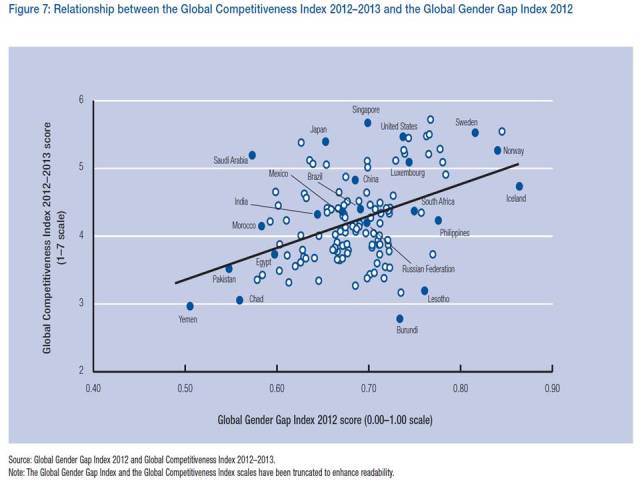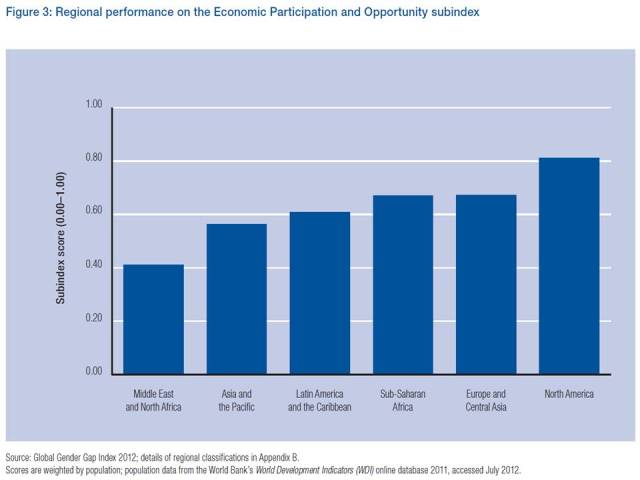The Global Gender Gap Report 2012 emphasizes persisting gender gap divides across and within regions. The 2012 version finds that the majority of countries have made only a slow progress on closing gender gaps. Most highly developed countries score well in terms of women’s economic empowerment, but not all of them record progress in terms of women’s political empowerment.
This year’s findings show that Iceland tops the overall rankings in The Global Gender Gap Index for the fourth consecutive year. Finland ranks in second position, overtaking Norway (third). Sweden remains in fourth position. Northern European countries dominate the top 10 with Ireland in the fifth position, Denmark (seventh) and Switzerland (10th). New Zealand (sixth), Philippines (eighth) and Nicaragua (ninth) complete the top 10.
The index continues to track the strong positive correlation between a country’s gender equality and its national competitiveness. Because women account for one-half of a country’s potential talent base, a nation’s competitiveness in the long term depends significantly on whether and how it educates and utilizes its women. Empowering women in terms of education, employment and income means a more efficient use of a nation’s human talent endowment. Reducing gender inequality therefore enhances productivity and economic growth.

Click on the graph for better readability
The Global Gender Gap index actually captures 4 dimensions:
- Educational Attainment (literacy, primary-, secondary- and tertiary-level school enrolment)
- Economic Participation and Opportunity (returns from education: employment, income and career advancement)
- Health and Survival (life expectancy, sex ratio at birth)
- Political Empowerment (women’s representation in parliament, in minister-level positions, in executive office)
North America, Europe and Central Asia score highest in terms of women’s economic participation and opportunity. Especially the Nordic countries have made it possible for parents to combine work and family, resulting in high female employment participation rates, more shared participation in childcare, more equitable distribution of labour at home, better work-life balance for both women and men and in some cases a boost to declining fertility rates. Policies in these countries include mandatory paternal leave in combination with maternity leave, generous federally mandated parental leave benefits provided by a combination of social insurance funds and employers, tax incentives and post-maternity re-entry programs. Together these policies have also led to relatively higher and rising birth rates occurring simultaneously with high female workforce participation
The Unites States score well in women’s economic participation due to increases in the perceived wage equality ratio and the estimated earned income ratio.

Click on the graph for better readability
However, the US score particularly low in terms of women’s political empowerment, mainly due to decreases in the percentage of women in ministerial level positions. Today, only 17% of parliamentarians are women in the US.
In Denmark, Sweden and Norway, political parties introduced voluntary gender quotas in the 1970s, resulting in high numbers of female political representatives over the years. In Denmark, in fact, this quota has since been abandoned as no further stimulus is required. Today, Sweden has among the highest percentages of women in parliament in the world (44.7%) while the other Nordic countries are almost as successful. These countries have a similarly strong record on the percentage of women in ministerial level positions.

Click on the graph for better readability
Countries in Asia and the Pacific score high in terms of women’s political participation, but very low in terms of health and survival. This bad score is caused by the continuing biased sex ratio at birth (sex selective abortion, female infanticide…).
Source: Résumé of the The Global Gender Gap Report 2012 by Angela Luci-Greulich
Related articles on this blog:
Gender equality ranking – clear winners and losers?
Economists for gender quotas in parliaments!
Gender Gap Index 2010: Gender equality much higher in Germany than in France?!

 Wikigender
Wikigender
Pingback: Your Life Could Depend On Your Ability To Sit Or Rise | My Sex Professor